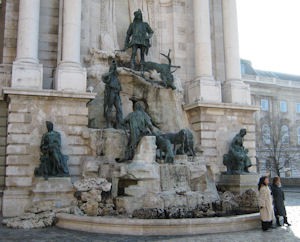 |
Across the bridge, we took the Funicular to the top.
Honestly, it would have been quicker to walk, but we were here in search of adventure and exploration, and the only way to do this, is to try new things (however boring they might be 🙂
We reach the top of Castle hill (made of limestone, it rises 550 feet above the Danube). The old town around here is the heart of tourism within the city.
These statues outside Buda Castle are probably in the top 5 I have seen anywhere in the world. |
| The Royal Palace was completed in 1424. Today it houses the Hungarian National Gallery, the Budapest History Museum and the National Library.
When we arrived, there were TV camera’s everywhere, as this Crane had turned over. Thankfully, it didn’t look like anyone had been seriously hurt. |
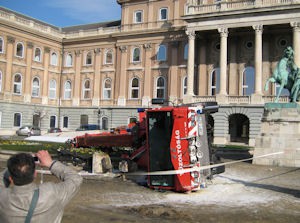 |
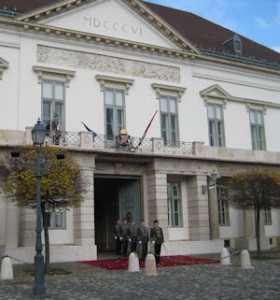 |
Just next to the Funicular is Sandor Palace.
It used to house the Prime minister, but today it is used for Presidential Offices (it was completely destroyed in the 2nd world war, and rebuilt afterwards).
We watched the rather camp changing of the guard. |
| I really liked the colour of the trees with the sun hitting them.
Basically, there is no significance to this picture, except that I like it. |
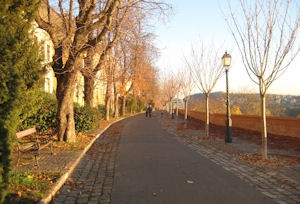 |
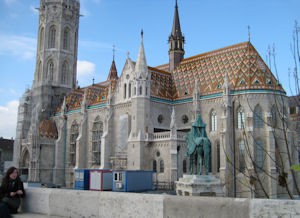 |
Matthias church.
It was described in my guidebook (before the idiot French people lost it !) as 13th century church named after 15th century king.
Considering the area is so popular for tourism, sign posts were virtually non existent.
I simply couldn’t find the military museum (which is a shame, as apparently, they have a really good exhibit about the 1956 uprising). |
| There were lots of Trabant cars.
Agi had commented that her car was very difficult to drive, as it had a quirky gearbox.
I saw this Mark III Ford Cortina. Same model as used in Life on Mars, one of the best TV programs of the last 20 years. Reminded me of my friend Frank who appeared in Life on Mars. |
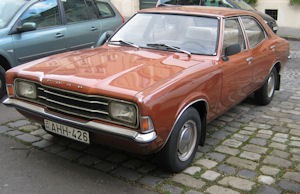 |
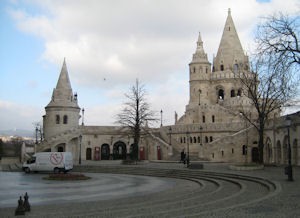 |
Fisherman’s bastion. A truly enchanting place on castle hill.
Its seven towers represent the seven Magyar tribes that settled in the Carpathian Basin in 896.
The Bastion takes its name from the guild of Fishermen that were responsible for defending this stretch of the city walls in the Middle Ages. It is a viewing terrace, with many stairs and walking paths.
It was designed and built between 1895 and 1902 on the plans of Frigyes Schulek. |
| It was the third day of our trip, so we decided to stop for a while and have a couple of pints.
We found a really atmospheric underground bar nearby. |
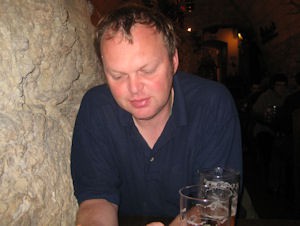 |
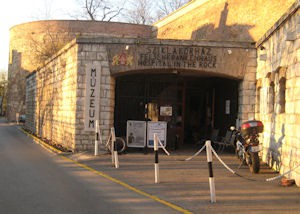 |
God spoke to me, and commanded me to find the Hospital in the Rock.
Well, when I say god, I’m talking about the god of adventure travel, Simon Calder, in his 48 hours in … series.
The Hospital in the Rock opened its doors in February of 1944. It was built to treat 60 to 200 soldiers but they ended up treating around 600 soldiers and civilians.
Beds built for one were ultimately shared between three people, with the least injured in the middle.
Mid siege, and out of supplies, the kitchen were forced to use horse-meat to feed their staff and patients.
Used again during the 1956 Hungarian Revolution 8 children were born here.
It was upgraded and extended to a nuclear bunker in the early 60’s because of the Cold War.
Designated “Top Secret” in the early 1960s with the code name LOSK 0101/1, it retained its classified status until 2002. |
| With advances in nuclear weapons, specifically the neutron bomb, the bunker’s ability to withstand the anticipated Armageddon came under question.
A caretaker couple took over maintenance of the facility to keep things like air circulation, heating and humidity control in working order.
The beds and other modern medical equipment were kept ready for use. It’s said the only time the X-ray machine was used, was by the janitor himself when he broke his finger.
Finally opened to the public in 2006, the present-day museum was opened in March of 2008. |
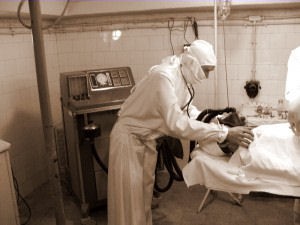 |
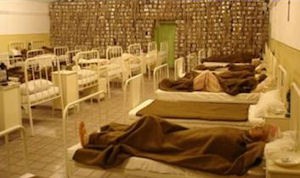 |
Walking around on an hourly guided tour, the control room and associated machinery are still in operating condition. All of the first aid supplies and medical equipment are either stockpiled in rooms, or set out on tables, ready for use.
The complex has dummy’s demonstrating most of the hospitals functions.
In other circumstances, it would look theatrical, but with the humming of the generator, the cold air and stark lighting it feels like one of those star trek moments when everything is frozen in time.
Run by a private company, their charter from the government says they must move out completely within 24 hours in case of a national emergency. |
| It got dark rather early, so I was able to get this picture of the Chain Bridge at night. |
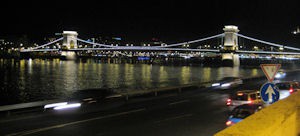 |
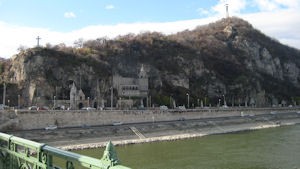 |
The following day (rather jaded from our whirlwind tour of Budapest) we head for Gellert hill. |
| I had seen the statue in several pictures, and the first thing that struck me, was how much smaller it was.
In the photo you can see, the pavement at the bottom and the top of the statues head, are less than 100m metres apart.
Gellert hill, takes its name from St Gerard who is credited with introducing Christianity to the area, by being thrown down a hill (well technically, he was rolled down the hill, in a barrel). |
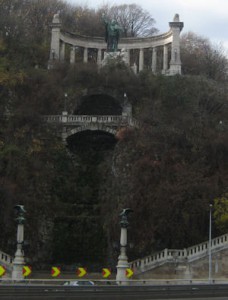 |
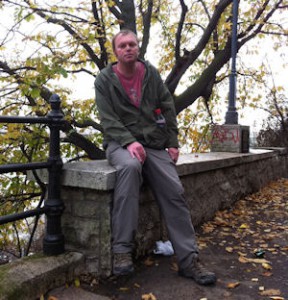 |
It was obvious that Glenn’s boot camp training was working, as he easily left me, on the walk up Gellert hill (although I wondered if he would have beaten me so easily, over 25 miles of flatter ground).
I stopped to rest, and in the picture, have a sort of ET “sticky out head”. |
| We reach the top of the hill to find 2 interesting things.
1. Glenn looking pleased with himself.
Glenn can be contacted through his Pine and Teak businesses, so I’ll just deal with the Citadel.
2. The Citadel fortress, built by the Habsburg in 1851 following the suppression of the 48-49 uprising.
It contained 60 cannon, but was largely for show.
The Hapsburg empire has always been a bit of a mystery to me. I mean you just know what the Roman, Ottoman, Egyptian empires where like, but what about the Hapsburg’s.
My ex-wife Sarah gave me the best explanation some years ago. They are basically, like the people in Chitty Chitty Bang Bang (the kidnappers, not Dick Van Dyke et al).
Today the Citadel, remains as a tourist attraction (and if it is, its probably the most hideous I have seen while travelling). |
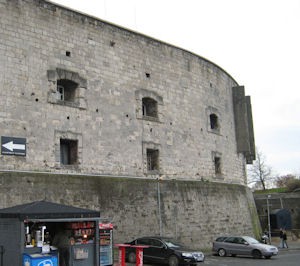 |
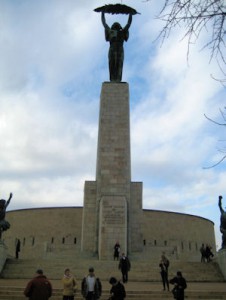 |
Nearby is the famous Liberation monument.
The statue was erected in 1947 after the second world war. The main figure is a woman, holding an olive branch, the symbol of peace in her hands. On both sides symbolic figures can be seen: the young man’s victory over the dragon represents the defeat of fascism.
Controversially, the inscription has been changed over time as it originally gave praise and thanks to the Soviets for liberating the country:
“Erected by the grateful Hungarian Nation in memory of the liberating Russian heroes”
It now reads:
“To the memory of all of those who sacrificed their lives for the independence, freedom, and success of Hungary “ |
| The area around is popular with walkers as it has lots of trails and forests and stuff like that.
As we wander around the parks nearby, we walk down the hill and see the Gellert baths, part of the famous Gellert hotel complex. |
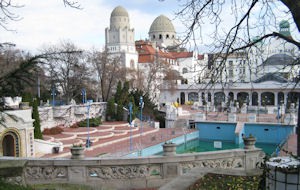 |
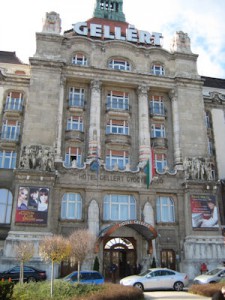 |
Built in 1916, the Gellert hotel was built in Art Nouveau style, as you can see from the entrance, which faces the Danube. |
| We head over to the famous Church in the Rock.
“built” in 1926, its modelled on the cave at Lourdes and houses the Pauline monastery.
It was kept secret during the communist era. When we got there, it had electric doors and the inside looked like a boutique
Once again, you had to pay to see a religious building, which I frankly resent, and once inside, you couldn’t take any photos. A bit disappointed, we carry on. |
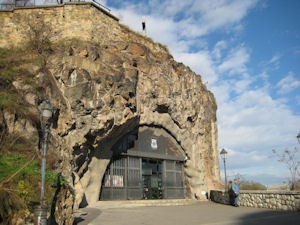 |
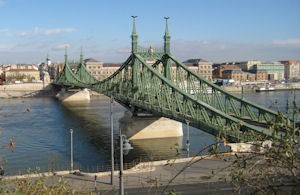 |
We wander back along the Liberty Bridge.
I don’t like to break with protocol, but I actually liked this bridge more than the Chain Bridge, which is considered a must-see. |
| Budapest has the largest Synagogue in Europe. It contains the Tree of Life Holocaust Memorial
Funded by the Emanuel Foundation (including Tony Curtis), in memory of the 600,000 Hungarian Jews who were murdered by the Nazis.
The tree, which is made of stainless steel and silver, is fashioned to look like a weeping willow.
Inscribed on its 4000 metal leaves are the names of Hungarian Holocaust victims. |
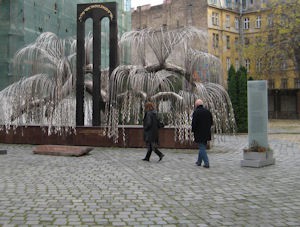 |
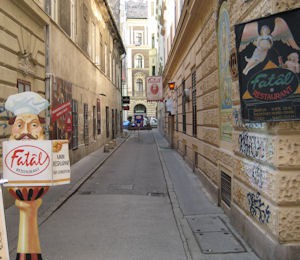 |
As we walked along Vaci street we passed this restaurant.
Something must have been lost in the translation. The food looked tasty and healthy, yet the restaurant was called Fatal !.
Back to our hotel, we jump in a Taxi for the Airport. What do I think overall. I really loved this place, and I’ll definitely come back. |